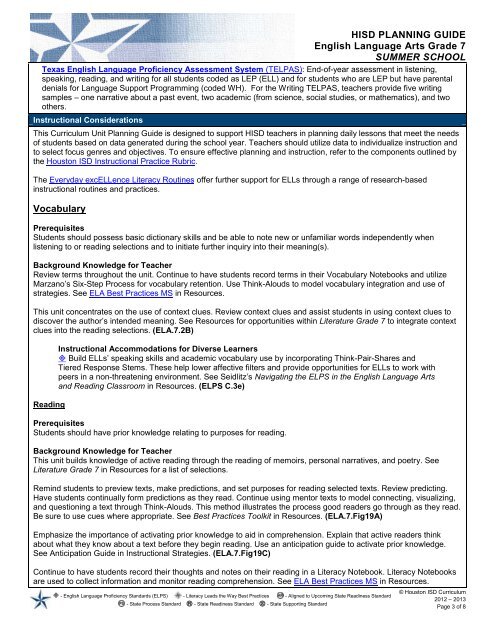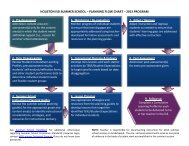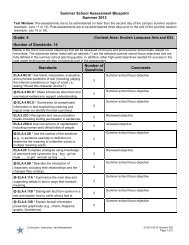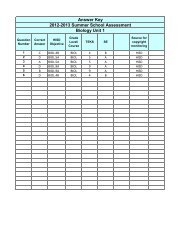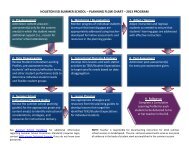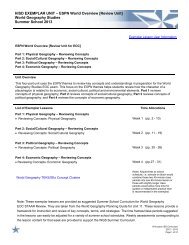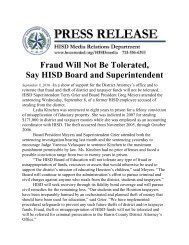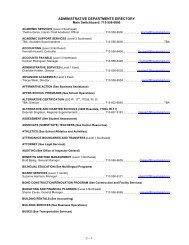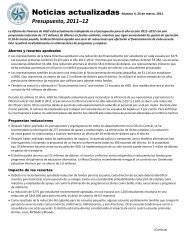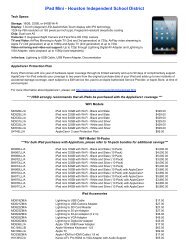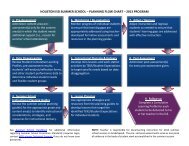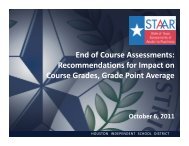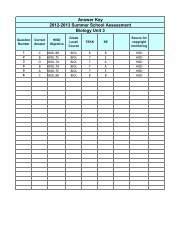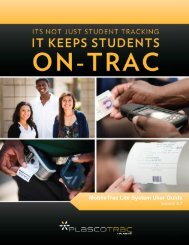HISD PLANNING GUIDEEnglish Language Arts Grade 7SUMMER SCHOOLTexas English Language Proficiency Assessment System (TELPAS): End-of-year assessment in listening,speaking, reading, and writing for all students coded as LEP (ELL) and for students who are LEP but have parentaldenials for Language Support Programming (coded WH). For the Writing TELPAS, teachers provide five writingsamples – one narrative about a past event, two academic (from science, social studies, or mathematics), and twoothers.Instructional ConsiderationsThis Curriculum <strong>Unit</strong> <strong>Planning</strong> <strong>Guide</strong> is designed to support HISD teachers in planning daily lessons that meet the needsof students based on data generated during the school year. Teachers should utilize data to individualize instruction andto select focus genres and objectives. To ensure effective planning and instruction, refer to the components outlined bythe Houston ISD Instructional Practice Rubric.The Everyday excELLence Literacy Routines offer further support for ELLs through a range of research-basedinstructional routines and practices.VocabularyPrerequisitesStudents should possess basic dictionary skills and be able to note new or unfamiliar words independently whenlistening to or reading selections and to initiate further inquiry into their meaning(s).Background Knowledge for TeacherReview terms throughout the unit. Continue to have students record terms in their Vocabulary Notebooks and utilizeMarzano’s Six-Step Process for vocabulary retention. Use Think-Alouds to model vocabulary integration and use ofstrategies. See ELA Best Practices MS in Resources.This unit concentrates on the use of context clues. Review context clues and assist students in using context clues todiscover the author’s intended meaning. See Resources for opportunities within Literature Grade 7 to integrate contextclues into the reading selections. (ELA.7.2B)ReadingInstructional Accommodations for Diverse Learners Build ELLs’ speaking skills and academic vocabulary use by incorporating Think-Pair-Shares andTiered Response Stems. These help lower affective filters and provide opportunities for ELLs to work withpeers in a non-threatening environment. See Seidlitz’s Navigating the ELPS in the English Language Artsand Reading Classroom in Resources. (ELPS C.3e)PrerequisitesStudents should have prior knowledge relating to purposes for reading.Background Knowledge for TeacherThis unit builds knowledge of active reading through the reading of memoirs, personal narratives, and poetry. SeeLiterature Grade 7 in Resources for a list of selections.Remind students to preview texts, make predictions, and set purposes for reading selected texts. Review predicting.Have students continually form predictions as they read. Continue using mentor texts to model connecting, visualizing,and questioning a text through Think-Alouds. This method illustrates the process good readers go through as they read.Be sure to use cues where appropriate. See Best Practices Toolkit in Resources. (ELA.7.Fig19A)Emphasize the importance of activating prior knowledge to aid in comprehension. Explain that active readers thinkabout what they know about a text before they begin reading. Use an anticipation guide to activate prior knowledge.See Anticipation <strong>Guide</strong> in Instructional Strategies. (ELA.7.Fig19C)Continue to have students record their thoughts and notes on their reading in a Literacy Notebook. Literacy Notebooksare used to collect information and monitor reading comprehension. See ELA Best Practices MS in Resources. - English Language Proficiency Standards (ELPS) - Literacy Leads the Way Best Practices - Aligned to Upcoming State Readiness Standard- State Process Standard R - State Readiness Standard S - State Supporting Standard© Houston ISD Curriculum2012 – 2013Page 3 of 8
Instructional ConsiderationsHISD PLANNING GUIDEEnglish Language Arts Grade 7SUMMER SCHOOLInstructional Accommodations for Diverse Learners Provide opportunities for ELLs to practice speaking using correct English sentence structures andconnecting words. Provide sentence stems such as “I don’t understand what/how…” and “So you’resaying…” to encourage students to seek clarification. See Seidlitz’s Navigating the ELPS in the EnglishLanguage Arts and Reading Classroom in Resources. (ELPS C.2d)Explain that authors write for a purpose. General purposes are to explain, persuade, inform, or entertain; however,authors usually write for more specific purposes. For example, a nonfiction narrative written to inform may have anunderlying purpose revealed through characters’ actions or events. As the unit progresses, have students cite evidenceto support their claims about the purpose of a text.Remind students of the differences between informational nonfiction and literary nonfiction. Have students read varioustypes of autobiographical texts including memoirs and personal narratives. Explain that each type of autobiographicalwriting, i.e. memoirs, diary entries, personal narratives, utilizes specific figurative language and literary devices as wellas structural elements such as a chronological order organizational pattern, first person points of view, and precisediction to create tone. Emphasize that figurative language and literary devices and elements of structure contribute toan author’s style. See Literature Grade 7 and Resource Manager Grade 7 <strong>Unit</strong> 4 in Resources.Review the difference between an autobiography and memoirs and personal narratives. Have students read varioustypes of literary nonfiction texts. Explain that literary nonfiction writing utilizes literary language and devices and istypically organized in a narrative structure and therefore includes plot, characters (real), setting, and conflicts.Emphasize that narratives usually use a chronological order organizational pattern. To support understanding, modelthe use of a graphic organizer such as a timeline or sequence of events chart to order events in a literary nonfiction text.Continue to have students record and discuss these elements in their Literacy Notebooks. See Best Practices Toolkit inResources.Review excerpts from film adaptations of autobiographical texts (i.e. Diary of Anne Frank, Invictus, or Malcolm X).Discuss aspects of texts that might be challenging to portray on film. Remind students that screenwriters and directorsoften take liberties or change events in order to complete a film. (ELA.7.7A)Literary devices include elements of style including imagery and figurative language. Define figurative language, diction,and imagery and provide examples from mentor texts. Have students place examples in their Literacy Notebooks.Reiterate that these elements are stylistic choices that reflect author’s purpose, create tone, and enhance a reader’sability to visualize a text. Encourage students to incorporate these elements in their narratives thoughtfully. (ELA.7.8A)Instruct students to use text evidence to support inferences. Model how to locate and to extract text evidence throughThink-Alouds. This mental process is more important initially than a formal written response. The focus should be onwhy a particular piece of text evidence was chosen and what logical inferences or conclusions can be drawn. Havestudents work in cooperative groups to discuss and compare notes. Utilize graphic organizers to support learning. SeeMaking Inferences from Text Evidence in Instructional Strategies and Best Practices Toolkit in Resources.(ELA.7.Fig19D)Instructional Accommodations for Diverse Learners The use of graphic organizers greatly enhances ELLs’ abilities to make connections and drawconclusions. Model and demonstrate the strategy first, using guided practice and mixed-ability partnersupport before expecting independent application. Partner ELL students with students more proficient inEnglish. Be sure to preteach and accommodate the academic language and vocabulary needed tounderstand and to complete the corresponding graphic organizer. (ELPS C.4j)Review Dialectical Journals. Explain that Dialectical Journals enhance comprehension of texts and provide commentaryas a means for students to review and analyze literature in discussion groups. Have students to record all learning intheir Literacy Notebooks. See Dialectical Journal, ELA Best Practices MS, and Laying the Foundation: A Resource and<strong>Planning</strong> <strong>Guide</strong> for Pre-AP English Grade Seven in Resources. (ELA.7.Fig19D) - English Language Proficiency Standards (ELPS) - Literacy Leads the Way Best Practices - Aligned to Upcoming State Readiness Standard- State Process Standard R - State Readiness Standard S - State Supporting Standard© Houston ISD Curriculum2012 – 2013Page 4 of 8


